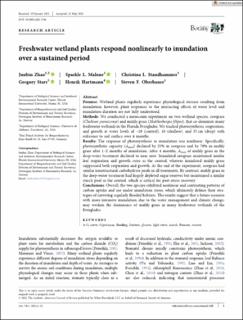| dc.description.abstract | Premise Wetland plants regularly experience physiological stresses resulting from inundation; however, plant responses to the interacting effects of water level and inundation duration are not fully understood. Methods We conducted a mesocosm experiment on two wetland species, sawgrass (Cladium jamaicense) and muhly grass (Muhlenbergia filipes), that co-dominate many freshwater wetlands in the Florida Everglades. We tracked photosynthesis, respiration, and growth at water levels of −10 (control), 10 (shallow), and 35 cm (deep) with reference to soil surface over 6 months. Results The response of photosynthesis to inundation was nonlinear. Specifically, photosynthetic capacity (Amax) declined by 25% in sawgrass and by 70% in muhly grass after 1–2 months of inundation. After 4 months, Amax of muhly grass in the deep-water treatment declined to near zero. Inundated sawgrass maintained similar leaf respiration and growth rates as the control, whereas inundated muhly grass suppressed both respiration and growth. At the end of the experiment, sawgrass had similar nonstructural carbohydrate pools in all treatments. By contrast, muhly grass in the deep-water treatment had largely depleted sugar reserves but maintained a similar starch pool as the control, which is critical for post-stress recovery. Conclusions Overall, the two species exhibited nonlinear and contrasting patterns of carbon uptake and use under inundation stress, which ultimately defines their strategies of surviving regularly flooded habitats. The results suggest that a future scenario with more intensive inundation, due to the water management and climate change, may weaken the dominance of muhly grass in many freshwater wetlands of the Everglades. | en_US |

